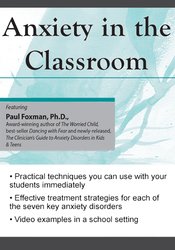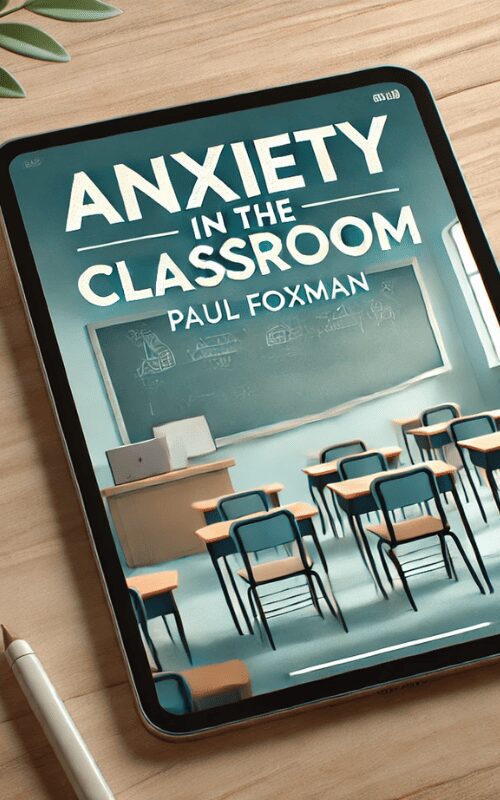Anxiety in the Classroom – Paul Foxman
Anxiety in the Classroom – Paul Foxman has the same quality as the author’s salapage.
Overview
Salepage check: Anxiety in the Classroom
Author: Paul Foxman
- Faculty:
- Paul Foxman
- Duration:
- 6 Hours 1 Minutes
- Format:
- Audio and Video
- Copyright:
- Jun 07, 2017
Description
- Practical techniques you can use with your students immediately
- Effective treatment strategies for each of the seven key anxiety disorders
- Video examples in a school setting
The increasing rate of stress and trauma to children, which includes divorce, global terrorism and violence, extensive technology use, media overload, bullying and diversity issues, has produced a “shell shocked” generation of students struggling to manage their anxiety. The challenge for those working in schools is to recognize the increasing anxiety level in students and help them cope.
Dr. Paul Foxman will teach you how, why and when anxiety develops in young people. The various manifestations for anxiety will be described, so that anxious students can be recognized and supported. Dr. Foxman will help you distinguish between normal anxiety and anxiety disorders, and give you a principle for making this distinction in school settings. Most importantly, you will learn practical strategies that can be applied immediately in the classroom setting and schools to reduce anxiety, enhance teaching effectiveness, and promote maximum learning.
Handouts
| Manual ZNM052180 (2.39 MB) | 61 Pages | Available after Purchase | |
| Instructions for ASHA Credit – SELF STUDY ONLY – 06/07/17 (0.03 MB) | Available after Purchase | ||
| ASHA Participant Form – SELF STUDY ONLY – 06/07/17 (1.54 MB) | Available after Purchase |
Outline
Nature and Causes of Anxiety
- How, when and why anxiety develops in children
- The anxiety temperament (biological sensitivity)
- The “anxiety personality” – assets and liabilities
- The role of stress in anxiety
How Anxiety Manifests in the Classroom
- Perfectionism
- Worry
- Task avoidance
- Restlessness and hyperactivity
- Attention deficits
- School avoidance
- Social isolation
- Depression and withdrawal
- Fatigue and low energy
- Low motivation
- Disorganization and poor time management
- Academic inconsistency or decline
- Learning disabilities
- Behavior problems
Seven Key Anxiety Disorders: Symptoms and Case Examples
- Separation anxiety disorder
- Panic disorder
- Generalized anxiety disorder
- Obsessive-compulsive disorder
- Social anxiety disorder (including selective mutism)
- Phobias
- Post-traumatic stress disorder
Classroom Interventions
- Assessing stress level in students
- 3-S approach to stress management (signs, sources and skillful solutions)
- Focusing the mind for learning
- Classroom friendly calming and relaxation activities
- Encouraging “flow”
- Mindfulness strategies
- Relationship building with anxious students
- Tips for reducing test anxiety
- Creating calm in the classroom
- 3 questions: intervention for anxious parents
- “Responsive Classroom”: applications and research findings
- Risk management with high-conflict divorce families
- Managing technology use in and out of school
- Best approach to bullying
- Anxiety curriculums for schools (friends for life, lifeskills)
- Special considerations for preschoolers
- Behavioral health recommendations
- How to be a role model for low stress and anxiety
Limitations of Research and Potential Risks
- Consider scope of practice
- Empirical and anecdotal evidence
- No “one size fits all” for any modality of anxiety treatment
Faculty
Paul Foxman, Ph.D. Related seminars and products: 7
Vermont Center for Anxiety Care
Paul Foxman, Ph.D., has led hundreds of workshops throughout the U.S. and Canada, and he has appeared on television and radio as an expert on the topic of anxiety. His books include The Clinician’s Guide to Anxiety Disorders in Kids & Teens (PESI, 2016), Dancing with Fear (Hunter House, 2007) and award-winning The Worried Child (Hunter House, 2004). He also co-authored a casebook, Conquering Panic and Anxiety Disorders (with Glatzer) (Hunter House, 2002). Dr. Foxman is known for his knowledge and clarity, sense of humor, compassion, and engaging speaking style.
Dr. Foxman is a clinical psychologist, as well as founder and director of the Vermont Center for Anxiety Disorders. In 1985 he co-founded the Lake Champlain Waldorf School in Shelburne, VT, now flourishing from kindergarten through high school. Dr. Foxman has over 40 years of clinical experience in a variety of settings including hospitals, community mental health centers, schools and private practice.
Dr. Foxman’s education includes Yale University (B.A. in Psychology), Peabody College of Vanderbilt University (Ph.D. in Clinical Psychology), and training at the Department of Psychiatry of Mt. Zion Hospital in San Francisco, the Kennedy Child Study Center in Nashville, and the San Francisco Psychoanalytic Institute.
Speaker Disclosures:
Financial: Dr. Paul Foxman is the founder/director of the Center for Anxiety Disorders. He is an author for Hunter House and receives royalties. He is an author for Jason Aronson, Inc. and receives royalties. He is an author for Da Capo Press and receives royalties. He receives a speaking honorarium from PESI, Inc.
Non-financial: Dr. Paul Foxman co-founded the Lake Champlain Waldorf School.
Curriculum
FAQs
Requirements
- Basic understanding of classroom management or educational practices.
- An interest in addressing anxiety in students.
- A digital device (computer, tablet, or smartphone) with internet access.
- No prior knowledge of mental health is required, but a willingness to engage with practical strategies is essential.
Features
- Expert Insights: Learn from Paul Foxman, a leading psychologist specializing in childhood anxiety.
- Practical Techniques: Evidence-based methods to identify and address anxiety in classroom settings.
- Interactive Learning: Case studies and examples to apply knowledge directly.
- Flexible Format: Online, self-paced access suitable for busy professionals.
- Comprehensive Coverage: Explore root causes of anxiety and develop effective interventions.
Target audiences
- Teachers and educators looking to support anxious students.
- School counselors and psychologists seeking evidence-based strategies.
- Parents wanting to understand and manage their child's anxiety in academic environments.
- Administrators and education policymakers focused on mental health initiatives.


